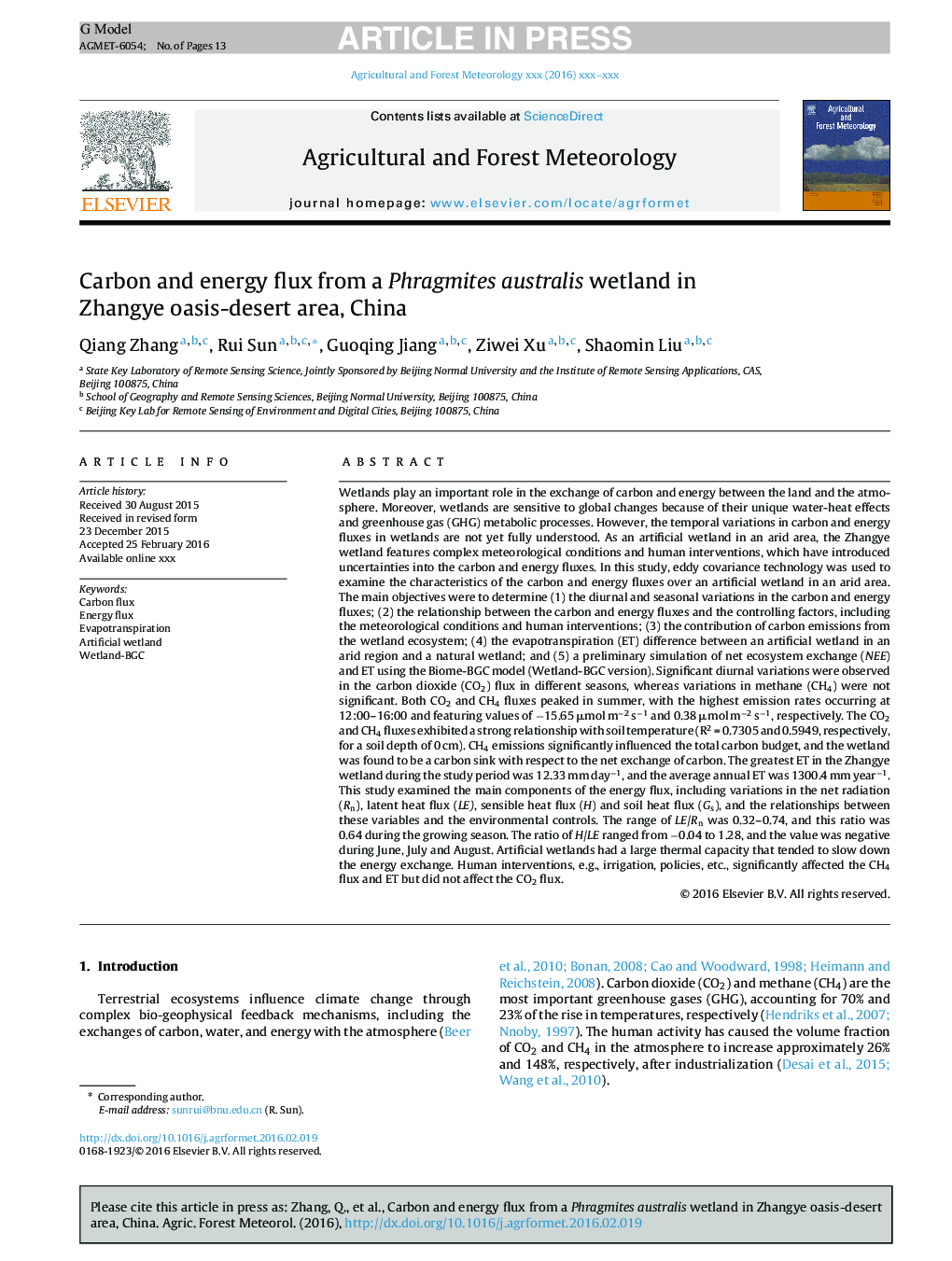| کد مقاله | کد نشریه | سال انتشار | مقاله انگلیسی | نسخه تمام متن |
|---|---|---|---|---|
| 4758977 | 1420866 | 2016 | 13 صفحه PDF | دانلود رایگان |
عنوان انگلیسی مقاله ISI
Carbon and energy flux from a Phragmites australis wetland in Zhangye oasis-desert area, China
دانلود مقاله + سفارش ترجمه
دانلود مقاله ISI انگلیسی
رایگان برای ایرانیان
کلمات کلیدی
موضوعات مرتبط
مهندسی و علوم پایه
علوم زمین و سیارات
علم هواشناسی
پیش نمایش صفحه اول مقاله

چکیده انگلیسی
Wetlands play an important role in the exchange of carbon and energy between the land and the atmosphere. Moreover, wetlands are sensitive to global changes because of their unique water-heat effects and greenhouse gas (GHG) metabolic processes. However, the temporal variations in carbon and energy fluxes in wetlands are not yet fully understood. As an artificial wetland in an arid area, the Zhangye wetland features complex meteorological conditions and human interventions, which have introduced uncertainties into the carbon and energy fluxes. In this study, eddy covariance technology was used to examine the characteristics of the carbon and energy fluxes over an artificial wetland in an arid area. The main objectives were to determine (1) the diurnal and seasonal variations in the carbon and energy fluxes; (2) the relationship between the carbon and energy fluxes and the controlling factors, including the meteorological conditions and human interventions; (3) the contribution of carbon emissions from the wetland ecosystem; (4) the evapotranspiration (ET) difference between an artificial wetland in an arid region and a natural wetland; and (5) a preliminary simulation of net ecosystem exchange (NEE) and ET using the Biome-BGC model (Wetland-BGC version). Significant diurnal variations were observed in the carbon dioxide (CO2) flux in different seasons, whereas variations in methane (CH4) were not significant. Both CO2 and CH4 fluxes peaked in summer, with the highest emission rates occurring at 12:00-16:00 and featuring values of â15.65 μmol mâ2 sâ1 and 0.38 μmol mâ2 sâ1, respectively. The CO2 and CH4 fluxes exhibited a strong relationship with soil temperature (R2 = 0.7305 and 0.5949, respectively, for a soil depth of 0 cm). CH4 emissions significantly influenced the total carbon budget, and the wetland was found to be a carbon sink with respect to the net exchange of carbon. The greatest ET in the Zhangye wetland during the study period was 12.33 mm dayâ1, and the average annual ET was 1300.4 mm yearâ1. This study examined the main components of the energy flux, including variations in the net radiation (Rn), latent heat flux (LE), sensible heat flux (H) and soil heat flux (Gs), and the relationships between these variables and the environmental controls. The range of LE/Rn was 0.32-0.74, and this ratio was 0.64 during the growing season. The ratio of H/LE ranged from â0.04 to 1.28, and the value was negative during June, July and August. Artificial wetlands had a large thermal capacity that tended to slow down the energy exchange. Human interventions, e.g., irrigation, policies, etc., significantly affected the CH4 flux and ET but did not affect the CO2 flux.
ناشر
Database: Elsevier - ScienceDirect (ساینس دایرکت)
Journal: Agricultural and Forest Meteorology - Volumes 230â231, 15 December 2016, Pages 45-57
Journal: Agricultural and Forest Meteorology - Volumes 230â231, 15 December 2016, Pages 45-57
نویسندگان
Qiang Zhang, Rui Sun, Guoqing Jiang, Ziwei Xu, Shaomin Liu,